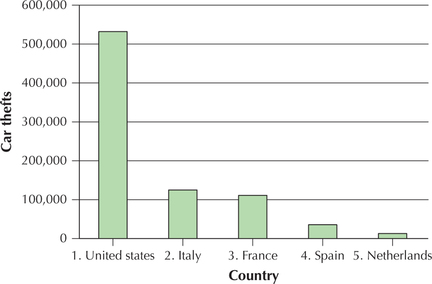EXAMPLE 26 Inappropriate choice of statistic
The United Nations Office on Drugs and Crime reports the statistics, given in Table 44, on the top five nations in the world ranked by numbers of cars stolen in 2012. The car thieves seem to be preying on cars in the United States, which has endured more than the next four highest countries put together. (See also the bar graph in Figure 54.) However, the United States has a much greater population than these other countries. Is it possible that, per capita (per person), the car theft rate in the United States is not so bad?
| Country | Cars stolen |
|---|---|
| United States | 532,900 |
| Italy | 126,627 |
| France | 111,305 |
| Spain | 35,131 |
| Netherlands | 12,575 |
Solution
In this case, the total number of cars stolen is an inappropriate statistic because the population of the United States is greater than the populations of the other countries.

To find the per capita car theft rate, divide the number of cars stolen in a country by that country's population. The resulting list in Table 45 of the top five countries for per capita car theft contains a few surprises. Note that the United States has dropped to third on the revised list.
| Country | Cars stolen per capita |
|---|---|
| Italy | 0.00208 |
| France | 0.00174 |
| United States of America | 0.00168 |
| Sweden | 0.00117 |
| Belgium | 0.00106 |
Developing Your Statistical Sense
Choose the Appropriate Statistic
The bottom line is that we need to be careful how we use statistics. Put in an extreme form, “Figures don't lie, but liars figure.” One table of statistics tells us the car theft epidemic is striking the United States with special vehemence. The other table asserts the contrary. An American insurance company looking to increase car insurance rates could point to the first table to support its rate request. A citizens group opposing the request could cite the second table. Which table of statistics is true? They both are! We need to be careful how we phrase our research questions and how we choose the types of statistical evidence we use to investigate research questions.
NOW YOU CAN DO
Exercises 3–5.